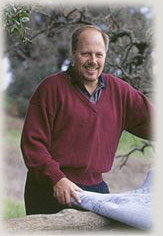| |
Architecturally
Sound
South Central PGA
GOLF Magazine
Volume 9, No.5
October-December 2002
Mal
Elliott profiles course designer Gary Linn
When
Gary Linn was a lad just big enough to pull a golf cart, he and
brother Brian would caddy for his mom and dad, Dick and Marilyn
Linn, at Sim Park or MacDonald Park, two of Wichita’s oldest
public courses. Their pay was a sundae at one of Wichita’s
earlier ice cream parlors.
Eventually there was a bigger payoff – a career with Robert
Trent Jones II, one of the world’s greatest golf-course architects,
and eventually a partnership in his own golf architecture firm.
Gary and Brian went through the junior golf programs at Sim Park,
in which their mother was a key figure. She also became a trustee
of the Wichita Junior Golf Foundation, which has provided opportunities
for thousands of Wichita junior golfers for the past 30 years.
Gary and Brian played on the Wichita North High School team and
Gary worked for head pro Jerry Hatfield at Wichita’s Rolling
Hills Country Club. The Linn brothers attended Kansas State University,
where Brian played on the golf team. Brian is a two-time champion
of the Wichita stroke-play championship, which was renamed in his
honor after he died of cancer in the 1980’s.
Armed with a degree in landscape architecture (1978), Gary went
to work. He soon got a call from former classmate Mark Rathert,
who asked Linn to join him as a member of the Robert Trent Jones
II firm.
That was the start of a 20-year tenure with Jones, which whisked
Linn to all parts of the world. Jones’s firm was the first
American company to undertake golf projects in the Far East.
While many of the old master architects looked for the ideal tract
of land where the natural features could be retained, the Jones’s
architects had to be creative and build where the customers wanted
a course. In Florida, there were no land features. “It was
dead flat,” says Linn.
In Japan, the problem was the exact opposite. The Japanese have
been crowded onto their tiny islands for so long that every inch
of arable land is in use. Previous attempts at golf-course construction
by engineers had scarred the land, said Linn.
The Japanese were masters at miniature land management such as their
beautiful Japanese gardens. But to build something as massive as
a golf course, it was necessary to knock down ridges and fill valleys.
“It was a fun challenge,” he said. “It was like playing
God. We had the ability. And the Japanese contractors were the best
in the world.”
Linn completed 17 international courses for Jones, including seven
in Japan and others in Korea, Taiwan, Thailand, Costa Rica, Columbia
and Canada.
Linn said Japan clearly influenced all of Asia on golf construction
“until its economy bit the dust. They would pre-sell 1,000
memberships.” He said the cost to build a course in Japan was
about $20 million.
Linn’s first project as the lead architect was the Shoreline
Golf Links of Mountain View, Calif., which opened in 1983. His latest
is the second 18 holes at Chenal Country Club in Little Rock, Ark.,
which was completed in late August of this year. Although he joined
his new firm of Knott-Brooks-Linn three years ago, he was the lead
man on the Chenal project in collaboration with Robert Trent Jones
II as a continuation of the contract for the original 18 holes.
After Chenal CC opened in 1990, it was ranked No. 3 in the nation
among the best new private courses by Golf Digest magazine in 1991,
No. 1 in the state of Arkansas and among Golfweek’s top 100.
The new 18-hole layout is slated to open in June 2003 and is even
tougher.
“The first course was more open and spacious with wider corridors,”
said Linn. The second 18 is purposely more challenging. It was cut
out of solid forest, is narrower and more environmentally sensitive.
It has a lot of native grasses and is longer and tighter.”
Two of Linn’s other projects in the Midwest are Tiffany Greens
in Kansas City, which has been a stop on the Senior PGA Tour since
1999, and Highland Springs in Springfield, Mo., which has been a
stop on the Hogan/Nike/Buy.com Tour since 1990.
Linn’s new firm is located in Mountain View, Calif., in the
heart of Silicon Valley. He said the recent slump in technology
stocks has hit the golf-course architecture business “big-time.”
There are few new courses being built but his company is doing a
lot of renovation work.
Chief among them are Foxtail Golf Club’s North and South courses
in Rohnert Park, 45 minutes north of San Francisco. It was originally
called Mountain Shadows but was renamed to reflect the extensive
and dramatic changes made by Linn’s firm.
There are five current members of the American Society of Golf Course
Architects with Kansas ties. In addition to Linn and Rathert, they
are Gregory Nash, a native of Hays; Frederick Bliss of Colby and
the retired Floyd Farley of Kansas City, who designed more than
100 layouts in Kansas and Oklahoma. |
|

